Business card printing is more than just ink on paper—it’s the handshake you leave behind. With DigiMarCon Dubai 2025 scheduled for October 1–2, professionals have a golden chance to stand out with cards that look and feel premium. From spot UV gloss to suede textures and duplex thickness, modern print finishes do more than impress—they communicate credibility, style, and intent. In this guide, we break down practical hacks and expert tips that ensure your business card isn’t just kept, but remembered.
Why Business Cards Still Matter in 2025
Even in a world overflowing with digital connections, business cards are far from obsolete. They deliver something digital formats can’t—a tactile, immediate connection. When you’re shaking hands at DigiMarCon or networking at a startup mixer, pulling out a business card still creates a more memorable exchange than sending a LinkedIn request.
A 2024 survey by Business Insider revealed that 72% of professionals judge a company’s credibility based on card quality. That snap decision takes just seconds, and a premium-feel card can influence whether your contact keeps or discards your information.
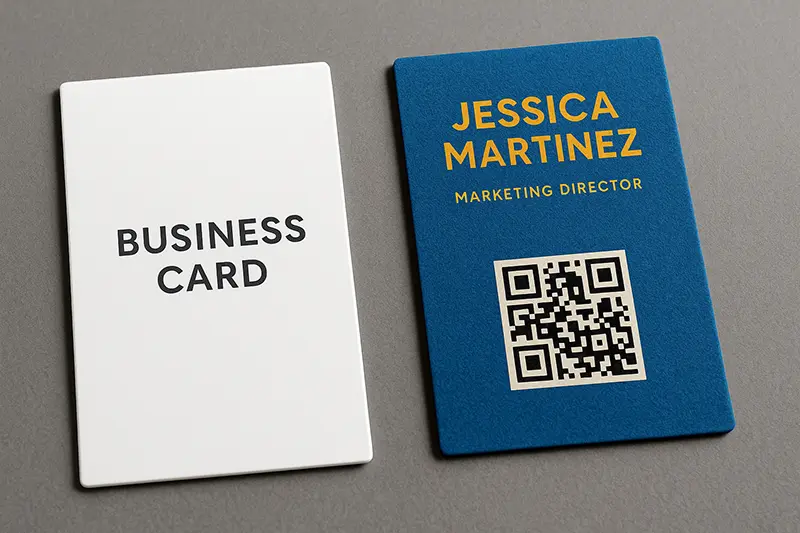
Colorful suede cards are remembered 10x longer than plain white cards
Also, research from Adobe shows that for every 2,000 business cards handed out, a company’s sales can increase by 2.5%. For a startup or solo entrepreneur, that’s a valuable return from a minimal print investment. In fact, printing 2,000 high-quality cards might cost only AED 1,200–1,500 ($320–$400)—a small price for potentially strong leads.
Color plays a huge role in retention. Colored business cards are kept up to 10× longer than plain white ones. At crowded events like DigiMarCon Dubai, this can mean the difference between a call-back and a missed opportunity. As entrepreneur Tim Ferriss puts it, “People remember how you make them feel, and your card is a part of that first feeling.”
Understanding Print Finishes: What Works and Why
When it comes to standing out, texture and weight speak louder than ink alone. Modern print finishes aren’t just cosmetic—they tell a story about your brand.
Let’s break down the key finishes that dominate today’s most effective business cards:
Spot UV
This is a clear gloss applied to specific areas—usually a logo, company name, or visual accent. It reflects light and gives contrast against a matte background, highlighting what matters most.
Suede (Velvet Lamination)
Suede-finished cards feel like soft cloth—luxurious, smooth, and elegant. They’re typically printed on 400–450 GSM cardstock and laminated with a soft-touch coating that resists fingerprints and scratches. They leave a lasting tactile impression.
Duplex (Sandwich) Cards
These involve gluing two cards together to create a thicker, more substantial product. The layers can feature contrasting colors or textures for a refined look. Most duplex cards range from 600 to 760 GSM, giving them a solid, impressive grip.
The point of these finishes is simple: to be remembered. Business cards at high-caliber events like DigiMarCon compete for attention—finish quality helps yours win.
Spot UV Secrets for Maximum Impact
Spot UV is one of the most visually striking finishes in business card printing. It’s not applied across the whole surface—just the parts you want to shine. This could be your logo, name, or key phrase, making them subtly catch the light and draw the eye.

Spot UV finish adds shine and focus to key card elements
🔍 How to Use Spot UV Like a Pro
-
Create Contrast: Use it sparingly on a dark matte background to make the gloss stand out. A deep navy or black base paired with gloss brings elegance without noise.
-
Apply the Ghost Effect: This is when spot UV is used without any underlying ink, creating a visual that appears only when viewed at certain angles. It’s mysterious, modern, and perfect for minimalist brands.
-
Limit to Key Elements: Apply UV coating to just one or two spots. Too much shine loses its impact. Focus on your brand logo or a call-to-action like “Let’s Connect.”
-
Be Wary of Small Fonts: Spot UV isn’t suitable for fine text—gloss can spread, causing blurring. Stick to bold, simple shapes and typography.
💡 Pro Insight: Raised Spot UV, which adds actual height to the coated area, gives a 3D tactile feel that’s hard to forget. This feature works beautifully on thicker cardstock, giving both visual and touch-based reinforcement of your brand.
Suede Lamination: Feel the Luxury
Suede-laminated business cards are known as “touchable branding” for a reason—they don’t just convey your brand visually but through texture. This finish is achieved by applying a velvet-like soft-touch laminate over thick card stock, usually around 19pt (approx. 450 GSM).
🌟 Why Professionals Love Suede Finish:
-
Scratch-resistant: Unlike glossy finishes that show every mark, suede lamination maintains a clean, smooth look even after frequent handling.
-
Moisture-repellent: Ideal for humid climates like the UAE, this finish resists smudges and fingerprints.
-
Soft yet Durable: The tactile softness impresses while the lamination reinforces strength—making it great for networking events.
-
Writable Surface: Whether you’re scribbling a follow-up note or adding a personal touch, suede accepts most pen types without smearing.
This finish speaks to refined professionalism, and it’s widely used in industries that rely on perception and prestige—from luxury consultants to creative agencies.
Duplex Cards: Thickness That Talks
Duplex cards are built by bonding two cards together to form a double-thick finished product. They not only look strong—they feel it. When someone holds your card, the substantial weight signals value and reliability.
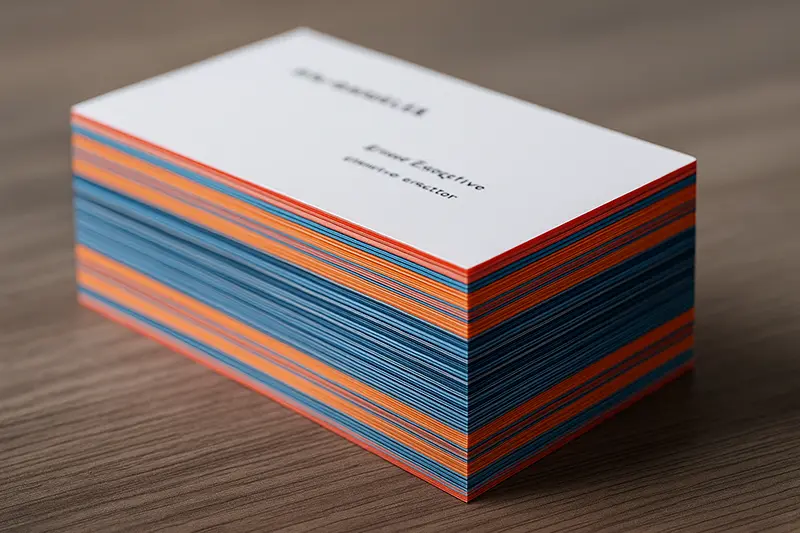
Duplex cards create a thick, layered feel with visual edge color contrast
💼 What Makes Duplex Cards So Effective:
-
Premium Thickness: Typically ranging from 400 to 760 GSM, duplex cards stand firm in wallets and hands—never flimsy, always bold.
-
Edge Styling: Many designs use contrasting colored layers or painted edges—like red sandwiched between white—for a powerful visual effect.
-
Enhanced Branding: With this format, one side can be branded in a bold color, while the other stays neutral for info clarity.
This format is perfect for executives, founders, and B2B professionals, especially those launching or pitching at high-stakes events like DigiMarCon. The feel of a thick, heavy card reinforces your authority—without saying a word.
Gold Foil & Color Edges: Eye-Catching Extras
Nothing says prestige like gold foil stamping. It’s a timeless method that adds shine and exclusivity to selected parts of your business card—usually logos, initials, or taglines.
✨ When and How to Use Foil:
-
Highlight Branding: Use foil on your logo or company name to attract the eye instantly.
-
Target Luxury Markets: Gold, silver, or rose gold foil resonates with audiences in real estate, hospitality, beauty, and premium services.
-
Dark Backgrounds Work Best: Foil pops more against black, navy, or burgundy backgrounds.
Also consider colored edges—a subtle but striking way to stand out even when your card is stacked with others. It’s one of those small touches that screams detail orientation.
When used strategically, foil and color edges turn your card into a conversation piece, not just a contact slip.
Creative Business Card Design Tips for DigiMarCon
A powerful business card isn’t just about finishes—it’s about smart, intentional design. At DigiMarCon Dubai, where you’ll be networking with decision-makers, clarity and creativity should drive your layout.
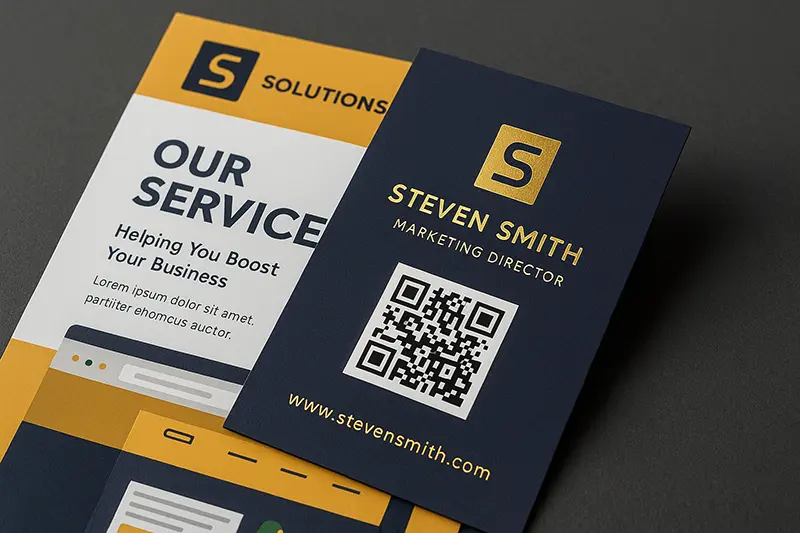
Branded QR codes and foil accents drive attention and digital action
🎨 Best Design Practices:
-
Use high-resolution vector logos (AI, EPS, PDF). This ensures sharpness during printing, especially with spot UV or foil overlays.
-
Add a QR code—but not just any code. Link it to a custom landing page, digital portfolio, or Google Ads campaign with UTM tracking.
-
Stick to font sizes 14pt and above. Readability matters more than style, especially in dynamic networking spaces.
-
Simplify your content: Include just the essentials—name, job title, logo, phone number, email, and QR code.
-
Whitespace is power: Crowding your card with info reduces its visual impact.
🧠 Bonus Strategy:
Use Google Maps SEO wisely—include a discreet code near your address such as: “Printing Expert in Dubai – Near Me”. This subtly connects offline materials to your digital footprint and improves local visibility.
Bundling for Success: The Startup Launch Package
If you’re unveiling a product, service, or personal brand at DigiMarCon, you need more than just cards—you need a complete visual pitch. This is where smart bundling pays off.
🚀 What to Include in the Package:
-
Suede Lamination + Spot UV + Duplex Card: This trio combines touch, gloss, and weight—perfect for a premium first impression.
-
Branded QR Code: Embed it with UTM tracking to measure traffic from cards to your Google Ads landing page.
-
Foiled Tagline or CTA: Highlight a unique offer or mission line in gold or silver foil for instant attention.
-
Consistent Branding: Use the same fonts, colors, and logos from your website and social media to build trust at a glance.
This package delivers style, function, and analytics. Every scan becomes a lead, and every interaction reflects your vision.
Common Mistakes to Avoid
Your card could be sleek—but even small errors can undercut your credibility. Here’s what not to do:
❌ Key Don’ts:
-
Overfilling the card: Too much info overwhelms. Prioritize essential details.
-
Glossy finishes on writable cards: They look good but resist ink. Go matte or suede if notes are likely.
-
Low GSM cards: Anything under 400 GSM feels cheap and bends easily. Use heavier stocks for professionalism.
-
Mismatched branding: If your card doesn’t match your website, logo, or social presence, it confuses prospects and weakens brand memory.
Remember, your business card is an extension of your brand, not an afterthought.
Best Practices for Print-Ready Files
You’ve finalized your design—great! But poor formatting can ruin even the most creative layouts. Follow these standards to get print-perfect results:
📁 What to Submit:
-
Vector files (PDF, AI, EPS): These maintain quality at all sizes.
-
Add 3mm bleed: Ensures designs extend to the edge without white borders.
-
Design in CMYK: RGB is for screens; CMYK ensures true-to-print colors.
-
Separate layers for each effect (spot UV, foil, embossed areas).
-
Clearly labeled fonts and properly embedded assets.
✏️ Quick Tip:
Double-check spelling, phone numbers, and emails. A typo on your card can cost you valuable connections—and it’s avoidable.
Why Choose Media Print UAE
For business cards in Dubai, Media Print UAE offers everything under one roof: design, print, and marketing. With deep expertise in graphic design logos, branding logos, and Google Ads management, they ensure your printed materials align with your digital campaigns. Whether you’re preparing for a global summit or growing your brand locally, they deliver professional results without the fluff.
Conclusion: Ready for DigiMarCon? Make It Count
At DigiMarCon Dubai, you’ll be one connection away from your next breakthrough. And your business card is your silent ambassador. By choosing premium finishes like spot UV, suede, duplex, and creative touches like foil or QR codes, you’re not just handing out paper—you’re delivering your brand.
Upgrade your card not to impress, but to be unforgettable.
Frequently Asked Questions
1. What is the best finish for premium business cards?
The best finish for premium business cards depends on your brand’s image and intended audience. Spot UV creates visual contrast and shine, suede lamination adds a soft-touch texture, and duplex printing offers a thick, high-quality feel. Many professionals combine these for a luxurious, memorable result.
2. Can I write on suede laminated business cards?
Yes, suede laminated business cards are writable with most pen types. Unlike glossy finishes, suede provides a matte surface that accepts ink without smudging, making it ideal for adding notes during networking events.
3. How thick should business cards be for events like DigiMarCon?
For conferences and expos, cards should be at least 400 GSM for durability. Duplex cards can reach up to 760 GSM, making them feel substantial and high-end—perfect for leaving a lasting impression at events like DigiMarCon Dubai.
4. How can a QR code be used effectively on a business card?
A QR code can lead users to a portfolio, contact form, or even a Google Ads landing page. Ensure it’s sized appropriately and tested for quick scanning. It’s best placed in the bottom corner or back of the card, separate from main contact details.
5. What is spot UV in business card printing?
Spot UV is a glossy coating applied to specific areas of the card—usually the logo or key text. It adds contrast, draws attention, and can be combined with raised UV for a 3D effect. It’s often used with matte backgrounds for maximum visual impact.
6. Do colored edges or foil stamping improve card retention?
Yes. Foil stamping (gold, silver, rose gold) and colored edges add luxury and uniqueness. These effects make cards more memorable and visually striking, helping ensure they’re kept longer—especially in competitive event settings.

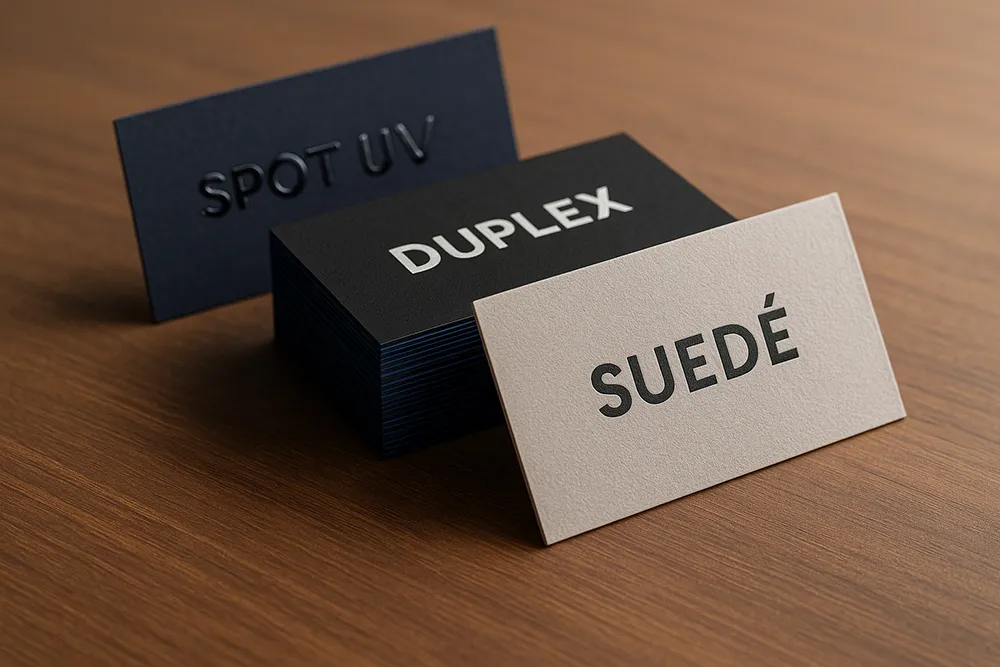
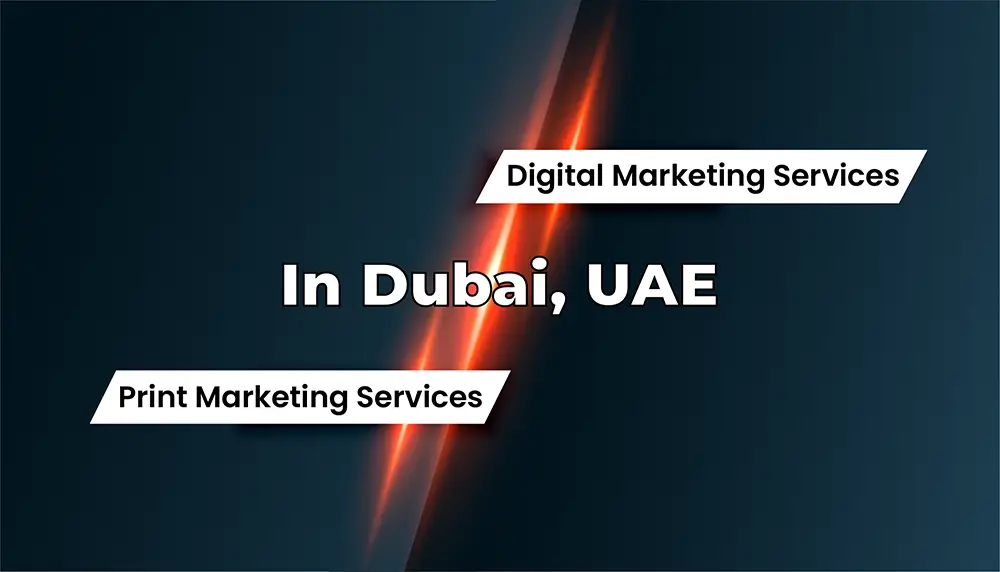



One Comment
Thanks for reading this article! I hope you found these business card printing insights helpful. If you have any questions or want to share your own card hacks, feel free to drop a comment below. I’m always open to new ideas—your feedback inspires better content!